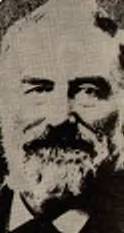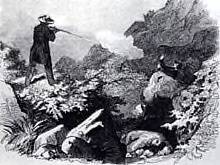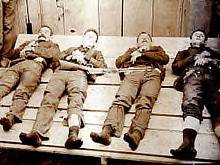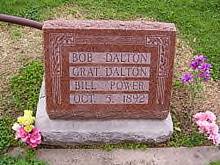Steve Venard from Wikipedia
| Steve Venard (Lebanon, Ohio c.
1823 - Nevada City, California, May 20, 1891) was a Northern California
lawman, and renowned road agent killer. In the course of his career, he
killed six highwaymen and made several important captures. He is known
for participating in one of the classic gun duels of the Old West, and
for being one of the most fearless lawmen of the California Gold Rush era.
Early years
Venard was born on a farm in Lebanon,
Ohio, USA. He received his education at Waynesville Academy in Waynesville,
Ohio. After moving to Newport (now Fountain City), Indiana, Venard became
the first teacher of the joint town and township school. Because of his
participation with the Underground Railroad, a bounty was put on him, so
he headed to California in March 1850 with a group of 24 others in covered
wagons, arriving in September 1850.
Career
Early on upon reaching California's
Gold country, Venard tried his hand at gold mining, settling first in Colfax,
but by December 1850, he had moved to the North Fork of the American River.
In 1851, he moved again, through Downieville, and then to Nevada City.
He decided to make Nevada City his home, and by 1853, had opened a grocery
store on Broad Street. By 1854, he became a partner in operating the Empire
Mining Company. In 1855, he became a Nevada County deputy but resigned
the following year. He ran for the office of Sheriff against Henry Plummer
in 1857 but lost. |
 |
| In 1864, Venard was
elected a part-time City Marshal in Nevada City. He also worked as a detective,
Wells Fargo guard and special officer.
Considered at the time as the "most
remarkable cleanup of road agents on record", Venard tracked and killed
three Wells Fargo stagecoach robbers on May 15, 1866 in the Yuba River's
Myers' Ravine with four shots from his Henry rifle, returned the stolen
$8,000 of Gold Dust, and then apologized for the excess shot. When offered
a reward by Wells Fargo, Venard accepted only half, and split the rest
with his posse. He received an inscribed, gold-mounted Henry rifle from
Wells Fargo, and Governor Frederick Low appointed Venard to his personal
staff with the rank of Lieutenant Colonel for "meritorious services in
the field". According to Harper's Weekly, "No romance could depict greater
bravery". |

Venard on the job |
In June 1866, Venard was appointed
resident deputy sheriff at Meadow Lake City; here, he was appointed City
Marshall and became a member of the Meadow Lake Yachting Club. By 1869,
he was commissioned as a Deputy Sheriff. After being sent to Sonoma County
in 1871 to investigate the Houx Gang, a group of Wells Fargo stage robbers,
Venard played an important role in the capture of John Houx.
After retiring from his career as
a lawman due to advancing age and chronic rheumatism, Venard became a partner
in the Detective Mine on Cement Hill in 1888.
Personal life
Venard was almost six feet tall.
He had wavy black hair, and a full beard. Never married, he spent his leisure
time reading books at the Library Association. Venard died of kidney failure
in 1891 in Nevada City. Having died penniless, his friends paid for his
burial at Nevada City's Pioneer Cemetery
|
| Dalton Gang from Wikipedia
The Dalton Gang was an outlaw group
in the American Old West during 1890-1892. They specialized in bank and
train robberies. They were related to the Younger brothers, who rode with
Jesse James, though they acted later and independently of the James-Younger
Gang. The three Dalton brothers involved in the gang were Gratton "Grat"
Dalton (b. 1861), Bob Dalton (b. 1869), and Emmett Dalton (b. 1871). A
fourth brother, William M. "Bill" Dalton (1866–1894), also had a career
as an outlaw, but operated as a member of the Wild Bunch.
Beginnings
The Dalton family came from Jackson
County, Missouri. Lewis Dalton was a saloon keeper in Kansas City, Kansas,
when he married Adeline Younger, the aunt of Cole and Jim Younger. By 1882,
the family lived in northeast Oklahoma, then known as the Indian Territory,
and by 1886 they had moved to Coffeyville in southeast Kansas. Thirteen
of the couple's 15 children survived to maturity.
The Daltons were "agrarian farmers".
It is suspected[citation needed] when the railroad "took" the family farm,
the event marked the beginning of the Dalton Brothers' life of crime, along
with other family tragedies, particularly the death of Frank.
Lawman
One son, Frank, was a Deputy US
Marshal who was killed in the line of duty in 1887. Frank had been the
most stable of the brothers, well grounded and mature, and by all accounts
Frank kept his brothers in line. They respected him, and had at times ridden
with him in posses. When killed, Frank had been tracking a horse thief
in the Oklahoma Territory. When he located the suspect on November 27,
1887, he confronted him and a shootout erupted, resulting in Dalton and
two outlaws being killed, and his deputy being wounded. On December 3,
the suspect was tracked by other lawmen, and another shootout erupted.
In that second shootout, Deputy U.S. Marshal Ed Stokley shot and killed
the suspect, but Stokley was also killed during the gunfight. Sam Wingo
was a US Marshal who ran with the gang robbing after he shot the wrong
man in Arkansas, and escaped custody in a subsequent shoot out with deputies.
Perhaps hoping to avenge their brother's
death[citation needed], the three younger Dalton boys—Grat, Bob, and Emmett,
—became lawmen. But in 1890, the boys moved to the other side of the law,
after not being paid for their duties as lawmen. Bob was always the wildest
one[citation needed]. He killed a man for the first time when he was just
19. He was a Deputy U.S. Marshal at the time and claimed the killing was
in the line of duty. Some suspected, however, that the victim had tried
to take away Bob's girlfriend. In March 1890, Bob was charged with introducing
liquor into the Indian Territory, but he jumped bail and did not appear
for his trial. In September 1890, Grat was arrested for stealing horses—
a capital offense—but either the charges were dropped or he was released.
Discredited as lawmen, the Daltons soon formed their first gang.
Outlaws
Bob recruited George "Bitter Creek"
Newcomb, Charley Pierce and Blackfaced Charlie Bryant to ride with him
and his brother Emmett. Bryant received his nickname because of a gunpowder
burn on one cheek. Grat was visiting his brother Bill in California when
the gang was formed, but joined it later, as did Bill Doolin, Dick Broadwell,
and Bill Power. Their first robbery target was a gambling house in Silver
City, New Mexico.
On February 6, 1891, after Jack
Dalton had joined his brothers in California, a Southern Pacific Railroad
passenger train was held up. The Daltons were accused of the robbery, based
on little evidence. Jack escaped and Bill was acquitted, but Grat was arrested,
convicted, and given a 20-year prison sentence. According to one account,
Grat was handcuffed to one deputy and accompanied by another while being
transferred by train. After the train had gone some distance, one deputy
fell asleep and the other busied himself talking to other passengers. It
was a hot day, and all the windows were open. Suddenly, Grat jumped up
and dived head first out of the train window. He landed in the San Joaquin
River, disappeared under water, and was carried downstream by the current.
The deputies were astounded. Grat must have taken the key to the handcuffs
from the first deputy's pocket as he slept and then timed his escape to
take place when he knew the train would be on a bridge. If he had landed
on the ground, he would almost certainly have been killed. Grat found his
brothers, and they made their way back to Oklahoma Territory.
Between May 1891 and July 1892,
the Dalton brothers robbed four trains in the Indian Territory. On May
9, 1891, the men held up a Santa Fe train at Wharton (now Perry). They
got away with several hundred dollars, only, but they had worked well as
a team. As they passed Orlando, they stole eight or nine horses. A posse
chased them, but the gang escaped.
Four months later the Dalton gang
robbed a train of $10,000 at Lillietta, Indian Territory. In June 1892,
they stopped another Santa Fe train, this time at Red Rock. Blackfaced
Charley Bryant and Dick Broadwell held the engineer and fireman in the
locomotive. Bob and Emmett Dalton and Bill Power walked through the passenger
cars, robbing the passengers as they went. Bill Doolin and Grat Dalton
took on the express car. They threw the safe out of the train. They gained
little for their efforts—a few hundred dollars and some watches and jewelry
from the passengers. The gang scattered after the Red Rock robbery, but
soon Blackfaced Charley was captured by Deputy US Marshal Ed Short. While
in route to be jailed in Wichita, Kansas, Bryant grabbed a gun from a railroad
worker assisting Deputy Marshal Short, and in the ensuing gunfight Bryant
and Short killed one another.
The gang struck again in July at
Adair, Oklahoma, near the Arkansas border. They went directly to the train
station and took what they could find in the express and baggage rooms.
Then they sat down on a bench on the platform, talking and smoking, with
their Winchester rifles across their knees. When the train came in at 9:45
p.m., they backed a wagon up to the express car and unloaded all the contents.
There were several armed guards on the train, but for some reason all 11
men were at the back of the train. The guards fired at the bandits through
the car windows and from behind the train. In the gun fight, 200 shots
were fired. None of the Dalton gang was hit. Three guards were wounded,
and a town doctor was killed by a stray bullet. The robbers dropped out
of sight, probably hiding out in one of several caves near Tulsa, Oklahoma.
Bank robbery
| The gang could have kept themselves
busy with train robberies, but Bob Dalton wanted to make sure his name
would long be remembered. He would, he claimed, "beat anything Jesse James
ever did—rob two banks at once, in broad daylight." On October 5, 1892,
the Dalton gang attempted this feat when they set out to rob the C.M. Condon
& Company's Bank and the First National Bank in Coffeyville, Kansas.
Since the locals were aware of what they looked like, they wore fake beards.
But they were still identified by one of the townspeople.
While the gang was busy trying to
hold up the banks, the people armed themselves and prepared for a gun battle.
When the gang exited the banks, a shootout began. There were three townspeople
shot, and Town Marshal Charles Connelly was killed when he ran into the
street after hearing gunfire, returning fire before he died killing one
member of the gang. Grat Dalton, Bob Dalton, Dick Broadwell and Bill Power
were killed. Emmett Dalton received 23 gunshot wounds and survived. He
was given a life sentence in the Kansas penitentiary in Lansing, Kansas,
of which he served 14 years before being pardoned. He moved to California
and became a real estate agent, author and actor, and died in 1937 at age
66. Bill Doolin, "Bitter Creek" Newcomb, and Charlie Pierce were the only
members left of the Dalton Gang, although none was present at the Coffeyville
shootout.Speculation later suggested that there had been a sixth man holding
horses in an alleyway and that he had escaped, and that man was believed
to have been Bill Doolin. However, that has never been confirmed.
Emmett Dalton would say years after
the robberies, and after his release from prison, that Deputy US Marshal
Heck Thomas was a key factor in their decision to commit the robberies.
According to Emmett, Thomas was relentless in his pursuit of the gang,
keeping them on the move constantly. With one big score from the two banks,
the gang intended on leaving the territory for a time, hoping the heat
brought down by Thomas would subside. |

Left to right: Bill Power; Bob Dalton;
Grat Dalton, Dick Broadwell

Grave of Dalton gang in
Coffeyville, Kansas
|
|